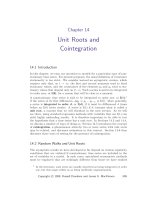International interviewing and counseling 9th ivey chapter 14
Bạn đang xem bản rút gọn của tài liệu. Xem và tải ngay bản đầy đủ của tài liệu tại đây (504.83 KB, 27 trang )
Intentional Interviewing and
Counseling:
Facilitating Client Development in a
Multicultural Society
9th Edition
Allen E. Ivey
Mary Bradford Ivey
Carlos P. Zalaquett
Copyright © 2018 Cengage Learning. All Rights Reserved.
Chapter 14
SKILL INTEGRATION,
DETERMINING PERSONAL STYLE, AND
TRANSCENDENCE
Copyright © 2018 Cengage Learning. All Rights Reserved.
Chapter Goals and Competency
Objectives (slide 1 of 2)
▲ Awareness and Knowledge
Review theories emphasized throughout the book. (Note that
detailed reviews of crisis counseling and cognitive behavioral
therapy were presented in Chapter 13.)
Review and integrate concepts, skills, and strategies learned in
previous chapters.
Explore a pre-interview checklist to help ensure that critical
points are covered in the first session.
Understand the place of case conceptualization, treatment
planning, referral, and relapse prevention, closely related to
action planning.
Copyright © 2018 Cengage Learning. All Rights Reserved.
Chapter Goals and Competency
Objectives (slide 2 of 2)
▲Skills and Action
Create long-term treatment plans for a client, and
keep systematic records.
Increase client take-home of thoughts, feelings,
meanings, and behavior in the fifth stage of the
interview through action planning and relapse
prevention.
Copyright © 2018 Cengage Learning. All Rights Reserved.
Skill Integration
Skill Integration: Integrate
the microskills into a wellformed interview and
generalize the skills to
situations beyond the training
session or classroom.
Anticipated Result:
Developing interviewers and
counselors will integrate skills as
part of their natural style. Each
of us will vary in our choices, but
increasingly, we will know what
we are doing, how to flex when
what we are doing is ineffective,
and what to expect in the
interview as a result of our
efforts.
Copyright © 2018 Cengage Learning. All Rights Reserved.
Decisional Counseling: Overview
▲ Philosophy
“Let’s be practical and find something that works.”
▲ Key Methods and Strategies
Five-stage decision structure + microskills
▲ Implications for your practice
Whether you favor person-centered, cognitive behavioral
therapy, or some other system, all require decisions and
ultimate client action in the real world.
Copyright © 2018 Cengage Learning. All Rights Reserved.
Person-Centered Counseling:
Overview
▲ Philosophy
Clients are the experts in their own life history and direction.
Personal self-actualization to reach one’s full potential.
▲ Key Methods and Strategies
Relationship and empathic understanding, the centrality of
emotion, and emphasis on listening.
▲ Implications for your practice
Regardless of your chosen theory, listening will always be
central in helping your client.
Copyright © 2018 Cengage Learning. All Rights Reserved.
Logotherapy: Overview
▲ Philosophy
Life always has meaning.
▲ Key Methods and Strategies
Discerning what we care for, what we are about, and our life’s
meaning and purpose seems to transcend all other issues.
▲ Implications for your practice
Exploring meaning can be particularly useful in crisis situations.
Copyright © 2018 Cengage Learning. All Rights Reserved.
Multicultural Counseling and
Feminist Therapy: Overview
▲ Philosophy
Both rest on a foundation of the cultural/environmental context.
▲ Key Methods and Strategies
Both focus on raising personality consciousness of how the individual
develops in a cultural/environmental context
▲ Implications for Practice
Remember that clients, regardless of race, ethnicity, gender, or
socioeconomic background, have a cultural background and history that
affect their identity and all the issues that they face.
Copyright © 2018 Cengage Learning. All Rights Reserved.
Importance of Case Conceptualization
and Working Formulation (slide 1 of 2)
▲ Your understanding of your clients, their issues, and the
decisions they want or need to make is foundational to
your work.
▲ A case conceptualization is an individualized application
of your theoretical model that takes into consideration
the antecedents of the case and your observations and
inferences.
▲ The data to be considered include what you may find in
the intake file, information from ongoing sessions, and
other sources.
Copyright © 2018 Cengage Learning. All Rights Reserved.
Importance of Case Conceptualization
and Working Formulation (slide 2 of 2)
▲ A case formulation will be produce based on all this
information.
▲ This formulation will be the working hypothesis used to
guide treatment, and it will evolve over sessions.
▲ A working formulation will help you make decisions about
the treatment plan, select interventions, assign
homework, cope with setbacks, assess outcomes,
determine paths to action, and complete treatment.
▲ Allen’s work with Mary illustrates many of these
concepts.
Copyright © 2018 Cengage Learning. All Rights Reserved.
Planning the First Session and
Using a Checklist
First Session Plan and Objectives
▲ Before the first session
Study the client file and anticipate what issues you think are
important.
Think how you want to help the client.
Consider what issues will be important in the session and how
you might handle them.
Prepare a tentative plan as a guide.
Be flexible and modify your plan if necessary.
Copyright © 2018 Cengage Learning. All Rights Reserved.
First Session Checklist
(slide 1 of 3)
Copyright © 2018 Cengage Learning. All Rights Reserved.
First Session Checklist
(slide 2 of 3)
Copyright © 2018 Cengage Learning. All Rights Reserved.
First Session Checklist
(slide 3 of 4)
Copyright © 2018 Cengage Learning. All Rights Reserved.
First Session Checklist
(slide 4 of 4)
Copyright © 2018 Cengage Learning. All Rights Reserved.
Additional Considerations: Referral, Treatment
Planning, and Case Management (slide 1 of 3)
Referral
▲ No interviewer has all the answers.
▲ Helps clients find community resources for their
continued growth.
▲ Helps when counselor skills are insufficient to aid client.
▲ Maintain contact with the client as referral process
evolves.
▲ Continue to work with the client while additional help is
acquired from specialized professionals.
Copyright © 2018 Cengage Learning. All Rights Reserved.
Additional Considerations: Referral, Treatment
Planning, and Case Management (slide 2 of 3)
Treatment Planning
▲ Treatment planning, in the form of specific written goals
and objectives, is increasingly standard.
▲ Often required by agencies and insurance companies.
▲ When possible, negotiate specific goals with the client.
▲ Write concrete and clear goals.
▲ Include specific indicators of behavioral change and
emotional satisfaction.
Copyright © 2018 Cengage Learning. All Rights Reserved.
Additional Considerations: Referral, Treatment
Planning, and Case Management (slide 3 of 3)
Treatment Planning
▲ May be structured using the five stages.
▲ Includes highlights from each stage.
▲ Summarizes issues.
▲ Includes decisions, interventions, and shifts in topic
direction.
▲ Captures generalization/homework plans.
Copyright © 2018 Cengage Learning. All Rights Reserved.
Case Management as Related to
Treatment Planning
▲ Case management requires the professional helper to
coordinate community services for the benefit of the
client, and very often the client’s family as well.
▲ Counseling and therapy are an important part of case
management, but only a part.
▲ Advocacy action is important throughout.
▲ In many communities and agencies, all of the necessary
services may not exist—and, equally or more likely, they
may not work together effectively. This may require
organizing to produce change.
Copyright © 2018 Cengage Learning. All Rights Reserved.
Maintaining Change:
Relapse Prevention
Relapse Plan
▲A relapse plan is developed to reduce client’s slips
or relapses.
▲The Maintaining Change Worksheet is completed
with the client to help prevent treatment lapses.
▲Anticipate possible obstacles to treatment.
▲Include strategies for treatment success.
Copyright © 2018 Cengage Learning. All Rights Reserved.
Your Turn: The Final Audio or
Video Exercise (slide 1 of 2)
Transcribe the session and use what you have
learned so far to fully analyze:
▲Your work
▲Consultation
▲Referral
▲Treatment planning
Copyright © 2018 Cengage Learning. All Rights Reserved.
Your Turn: The Final Audio or
Video Exercise (slide 2 of 2)
▲Cultural/environmental/contextual issues
▲Evaluation of your work
▲Your current natural style and expertise
▲Compare your current performance with the
transcript or recording of the session you
conducted earlier, in Chapter 1.
Copyright © 2018 Cengage Learning. All Rights Reserved.
Summary: Skill Integration and Determining
Personal Style (slide 1 of 2)
▲ Skill integration combines the microskills, stages of the
interview, and your natural expertise into the interview or
counseling session.
▲ The chapter presents a brief review of several
counseling approaches (e.g., decisional counseling,
logotherapy).
▲ A case conceptualization is an individualized application
of your theoretical model that takes into consideration
the antecedents of the case and your observations and
inferences.
Copyright © 2018 Cengage Learning. All Rights Reserved.
Summary:
Skill Integration and Determining Personal Style
(slide 2 of 2)
▲ Using the checklist helps you systematically plan for the initial
session using the five-stage structure and reduces the chances of
missing the basics.
▲ Know your community. What medical offices are available? What
social services are available for additional treatments, financial
assistance, and advice?
▲ A treatment plan is a long-term plan for conducting a course of
counseling sessions.
▲ Case management requires the professional helper to coordinate
treatment plans with community services and family support
systems for the benefit of the client.
Copyright © 2018 Cengage Learning. All Rights Reserved.









